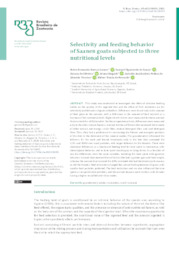Selectivity and feeding behavior of Saanen goats subjected to three nutritional levels.
Selectivity and feeding behavior of Saanen goats subjected to three nutritional levels.
Autoria: GOMES, H. F. B.; SOUZA, S. F. de; OLIVEIRA, D. de; BIAGIOLI, B.; TEIXEIRA, I. A. M. de A.; RESENDE, K. T.
Resumo: This study was conducted to investigate the effect of selective feeding habits on the quality of the ingested diet and the effect of feed restriction on the selectivity and behavior of goats in feedlots. Differences were found only in the amount of feed given to the animals, with a difference in the amount of feed rejected as a function of the nutritional level. Higher levels of orts were measured for those animals that received the ad libitum diet. For the composition of orts, differences were measured only in the ether extract fraction. Animals fed the ad libitum diet increased their intake of ether extract and energy, crude fiber, neutral detergent fiber, and acid detergent fiber. Thus, they had a preference for consuming the fibrous and energetic portions of the diet to the detriment of the mineral matter. The granulometry influenced the leftovers for the male and female treatments only in the diet that contained the 2.00- and 0.063-mm sized particles, with larger leftovers for the females. There were statistical differences as a function of feeding level for time spent in rumination, with stereotypical behavior, and in time spent standing up or lying down. As a function of sex, the differences were the same variables, including the time spent with agonistic behavior. Animals that received the ad libitum diet had a greater gain and final weight, whereas the animals that received the 60% restricted diet had the lowest performance, as did the females. Feed restriction changed the natural feeding behavior of goats, with smaller feed particles preferred. The feed restriction and sex also influenced the time spent on nonproductive activities, and the animals became more restless, with females having a higher social behavior than males.
Ano de publicação: 2020
Tipo de publicação: Artigo de periódico
Unidade: Embrapa Tabuleiros Costeiros
Palavras-chave: Alimentação, Animal feeding, Cabra, Caprino, Caprinocultura, Food intake, Goats, Granulometria, Ingestão, Ruminante
Observações
1 - Por padrão são exibidas publicações dos últimos 20 anos. Para encontrar publicações mais antigas, configure o filtro ano de publicação, colocando o ano a partir do qual você deseja encontrar publicações. O filtro está na coluna da esquerda na busca acima.
2 - Para ler algumas publicações da Embrapa (apenas as que estão em formato ePub), é necessário ter, no celular ou computador, um desses softwares gratuitos. Sistemas Android: Google Play Livros; IOS: iBooks; Windows e Linux: software Calibre.
Acesse outras publicações
Acesse a Base de Dados da Pesquisa Agropecuária (BDPA) para consultar o acervo completo das bibliotecas da Embrapa.

